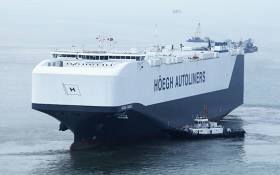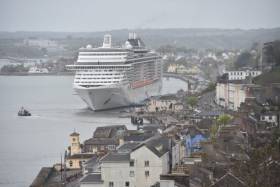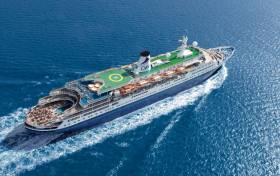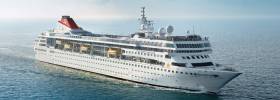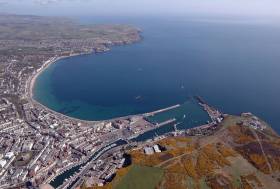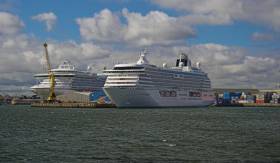Displaying items by tag: Cruise Liners
Dublin Port 'Horizon' Changes With World's Largest PCTC
#WorldsLargest – The World's largest pure car and truck carrier (PCTC) vessel, Höegh Target, with a 14 deck capacity for 8,500 car equivalent units, made another call to Dublin Port today along with a giant cruiseship, writes Jehan Ashmore.
The arrival from Rotterdam of the 76,420 gross tonnes PCTC, is impressive given not just because of the sheer overall size of the leadship of six ‘Horizon’ class Chinese built newbuilds, but also the imposing square shaped upper superstructure at the bow. This compared to a circular conventional car-carrier design, is to maximise additional space to enable a total deck area equal to the size of 10 football fields or 71,400 sqm. Of the 14 decks, five are capable of been 'lifted'.
It is claimed by Norwegian operator, Höegh Autoliners, that the 12 meter width ramp could easily crowd 75 elephants! on the stern ramp which takes 375 tonnes of cargo weight. The final Horizon class that are Post Panamax vessels, is to be delivered this year and they are each estimated to emit 50 per cent less CO2 per car transported than a standard car carrier.
At 200m in length, Höegh Target is some 89m short of the ‘Grand’ class cruiseship, Caribbean Princess which too is docked in port.
As reported today, the 19 deck Caribbean Princess with more than 3,000 passenger capacity called from Cobh, Cork Harbour and is berthed at Ocean Pier. While on the other side of the pier is where Höegh Target docked within Alexandra Basin east.
Both vessels present a temporary high-rise environment on the port estate, where such large vessels are increasing in number to the port. This has led to the Dublin Port Company’s ABR project costing €277m, the largest single capital investment project in the port for 200 years.
The ABR is to permit very large ships with even deeper drafts following major dredging, to dock inside the port.
Cork’s ‘Caribbean’ Caller Cruises to Capital
#CaribbeanCall - Caribbean Princess of 112,894 tonnes sailed overnight from Cobh, Cork Harbour and made a very early arrival call of 03.30 to Dublin Port this morning, writes Jehan Ashmore.
The Princess Cruises call follows that of another giant MSC Splendida of 137,936 tonnes that made a recent return to the port following a debut to Dublin last season. This year is a record breaking season with 113 calls scheduled and bringing around 180,000 visitors.
At 289m Caribbean Princess may not be the longest ever cruiseship to dock in Dublin Port as demonstrated by the 333m MSC Splendida with up to 4,600 passengers. Today's call of the impressive 'Caribbean' that towers 19 decks alongside Ocean Pier, is one more deck higher than the 'Fantasia' class MSC Splendida.
The 3,142 capacity Caribbean Princess is one of the most frequent class of cruiseships to visit Dublin Port over the last decade. In 2004 the ‘Grand’ class leadship, Grand Princess made an inaugural call which then broke the port record as the first cruiseship to exceed 100,000 gross tonnes.
Princess Cruises is operated by the world’s largest cruise company, the US based Carnival Corporation which among its other subsidiaries includes P&O Cruises. Last year their 700 passenger Adonia called to Cobh last year.
Under a new brand ‘fathom’ the Adonia, made a historic call to Havana, Cuba this month, the first US cruise ship to visit the country in almost four decades.
#BusyCork - Cork's economy writes the Evening Echo, is set to be boosted by cruiseships bringing almost 20,000 passengers and crew expected in a 10-day period.
Port of Cork officials estimate that 13,500 passengers and 5,000 crew will pass through Cobh in a 10-day period, beginning with yesterday’s arrival of the MSC Splendida. The longest cruise ship to ever visit Irish shores (including Dublin Port), at 333 metres llong, brought some 4,600 passengers and crew to Cobh.
The luxurious liner, which has more than a dozen bars and lounges along with four swimming pools, a spa, Turkish baths, squash courts and a Formula 1 simulator across its 18 decks, will return to Cobh next weekend.
In the interim, a further five vessels will dock at Cobh’s cruise terminal. The town will welcome more than 50 ships in total this year, with the cruise liner season running until December 19, bringing a multi-million euro boost to the local economy.
For more on the story, click here.
Afloat.ie has listed the cruise ship list for beyond the next 10 days to include further callers to the end May. Note that not all the cruiseships will berth at Cobh Cruise Terminal but throughout Cork Habour.
For updates to schedules click here.
Classic Liner to Cruiseship Calls to Capital
#ClassicLiner – A classic liner built for the Soviets more than 50 years ago that became a cruiseship sailing the seven seas and to both poles, called to Dublin Port today, writes Jehan Ashmore.
Marco Polo which is home-ported in London (Tilbury), is a classic ship steeped in maritime tradition and in which operators, Cruise & Maritime Voyages have a loyal following on this traditional ship.
The ocean-going lady of the sea had docked at Dublin mid-morning as part of UK and Irish ports cruise. Yesterday, her passengers visited western Scotland, to Tobermory on the Isle of Mull.
Today, passengers are exploring the capital and environs before re-embarking the 22,080 tonnes veteran vessel this evening. A departure time of 2200 is scheduled for the next port of call, the Scilly Isles off Cornwall.
The cruiseship is docked at Dublin’s Ocean Pier, apt given she served as a transatlantic liner between the USSR and Canada as the Alexandr Pushkin. The second of a quartet of the ‘poet’ class sisters was named after Russia’s greatest poets and writers. She was built in 1965 at the Mathias-Thesen Werft in Wismar, in the former East Germany.
Alexandr Pushkin operated in the summer between Leningrad, Bremerhaven, London, Le Havre and Montreal, a liner service she dutifully carried out until the late seventies. During the winter she cruised in warmer climes while mostly on charter to western companies.
The 800 capacity cruiseship was extensively re-built in 1993 and still retains classic lines, where tiered sun decks featuring a swimming pool and whirlpools overlook a cruiser stern. More unusual are the open decks below the bridge and overlooking the bow, a feature notably absent from today's giant enclosed cruiseships.
#CruiseRosslare - Afloat’s tracking of known Irish Sea timber-trading cargoships recently led to Rosslare, synonymous for its ferries, is to welcome more business with a first cruise call in more than two decades, writes Jehan Ashmore.
In early July the honour of this inaugural cruise call will go to Fred Olsen Cruise Lines Braemar with more than 900 visiting passengers. The 24,344 tonnes vessel is to dock within the harbour and remain in port for up to 12 hours.
Last year Pheonix Reisen's similar capacity cruiseship Albatros which has a deeper draft was scheduled to anchor offshore. The call however was cancelled due to bad weather conditions preventing anchoring and tendering visitors ashore. To read more click here.
The call by Braemar this summer will be more keenly awaited by Rosslare Europort, where the harbour authority is unique for an Irish port in that it is operated by Irish Rail (Iarnród Éireann).
In addition the cruise call is to boost the season for businesses notably running visitor attractions in the ‘model’ county and that of Wexford town.
As reported previously on Afloat, Braemar took part in Fred Olsen's first ever fleet gathering to one port and all at the same time. The event took place in Bergen last year where the origins of Fred Olsen date back to 1848.
Since 1987 the operator have concentrated cruises departing from UK ports, through Southampton, Liverpool, Newcastle, Dover, Tilbury, Harwich and Falmouth.
#KeynoteSpeaker - Carnival UK's chairman David Dingle, will be the keynote speaker at the Cruise Europe Conference (CEC) in Dublin next month. He will present the ‘State of the Industry in Europe’ on the morning of May 31.
Dublin Port Company recently launched Cruise Dublin, a cruise development and marketing agency, in March. It will work with its members from retail outlets, visitor experiences and tourism bodies to promote Dublin. Cruise tourism is growing at 20% a year.
Pat Ward, head of corporate services DPC, said: “We want to promote Dublin as a premium cruise destination directly to cruise companies and work with businesses in Dublin to tailor packages to the needs of the cruiselines and their passengers.”
For passengers who want to explore on their own a Cruise Dublin Visitor Card is being developed.
Manx Government Upgrades Plans to Drive Cruise Sector
#CruiseIOM - The Isle of Man Government last year appointed Neptumar (IOM) Ltd, a subsidiary of Dohle (IOM) Ltd, as its cruise consultant as part of a new strategy to drive forward cruise business in the Isle of Man.
According to Cruise Europe, bookings for 2016 are looking good with 19 vessels expected to call at the Isle of Man, either at anchorage or alongside at the Victoria Pier which can take vessels up to 155m in length.
As part of the new strategy the Isle of Man is reviewing its harbour facilities and has planned some upgrades this year to the Victoria Pier, including the fenders, to make berthing more comfortable for visiting cruise vessels.
Routine maintenance and upgrade to the Douglas Sea Terminal will also take place and this year there will be a retail outlet in the welcome centre selling Manx produce and local crafts.
The Vikings are set to dominate the Isle of Man in 2016 with exhibitions hosted by Manx National Heritage, the organisation responsible for protecting and promoting the Isle of Man’s heritage and culture. Many of these sites feature in shore excursions.
On arrival passengers will see the Tower of Refuge which was built on the reef in 1832 following several shipwrecks. Sir William Hillary, who helped to found the Royal National Lifeboat Institution, ordered the construction because he wanted a refuge for survivors until help could arrive.
Cruise Europe Speakers Lining Up for Dublin Conference First
#CruiseEurope – Cruise Europe which has members from within northern and Atlantic Europe will be hosting the organisation’s annual conference in Dublin as previously reported on Afloat. This will be the first time the capital has hosted the major industry sector event.
More than 200 delegates from across Europe will gather for the Cruise Europe Conference between May 31 to June 2 at the Gibson Hotel located in the Point Village. The venue neighbours the port site to where a dedicated purpose built €30m cruise terminal, another first for Dublin was granted permission last year.
The double-cruise berth facility is part of the €230m Alexandra Basin Redevelopment project will be able to handle the world's top ten largest cruise liners, including the 360m long Allure of the Seas.
“We have a great line-up of speakers,” said Jens Skrede, managing director CE, who announced the participation of Miguel Reyna, director commercial development Royal Caribbean Cruises Ltd; Russell Daya, executive director global port operations & developments, itinerary and strategic planning Disney Cruise Line; and Clare Ward, senior commercial planning manager Fred Olsen Cruise Lines. Jens added that “more speakers will be announced later”.
Nigel Lingard will once again moderate the event and there will be plenty of time to network during the social events. After the AGM on Tuesday, there will be an open-top bus tour of the city which will end up at the Guinness Storehouse for a tour, informal dinner and entertainment like only the Irish know how.
The gala evening will take place after the main conference on Wednesday. It will be held at the stunning Royal Hospital Kilmainham which has been a place of caring since 1680.
Cruise Ships 'Super-Sized' Could Still Come to Dún Laoghaire Harbour
#SuperSized - A berth for “super-sized” cruise ships in Dun Laoghaire Harbour could still be provided in spite of the introduction of a development plan which blocks their entry to the harbour.
Councillors have inserted a provision in the new county development plan to limit the size of vessels that can enter the harbour to 250m. However, the move may not be enough to topple a planning application from Dún Laoghaire Harbour Company for a new cruise berth.
In a vote on the county development plan on Wednesday, councillors agreed to “preserve the integrity, natural beauty and historical significance of the harbour by protecting this central area from any cruise berth that would allow cruise ships longer than 250m to come directly into the harbour”.
For more The Irish Times has the story here.
Hurtigruten to Modify Explorer Ships for Shore Power
#ShorePower - Hurtigruten has announced plans to modify several of its vessels for shore power during first half of 2016.
The initiative follows a stronger environmental focus in the Norwegian company, which operates a fleet of 13 explorer vessels among them the new MS Spitsbergen. The shore power installation will significantly reduce fuel consumption and air pollution during port calls.
The company has signed an agreement of intent with the port of Bergen for development of the land-based shore power equipment – and is encouraging other ports to follow.
Initially, three vessels operating the Norwegian coast are being modified to connect to shore power installations during port calls. The first ship to be prepared for shore power is MS Kong Harald, which is currently being refurbished at Norway’s Fosen Yard.
Throughout the first half of 2016, another two vessels will have shore power installed, with the ambition to modify three more ships.
“To succeed with the green shift at sea, maritime stakeholders must commit to the objective, and cooperate. Cruise lines, ports, tech industry and politicians must pull in the same direction. A combination of incentives and regulations must guide the development of a greener industry. Shore power should be equally available in ports as the fenders are. We hope our initiative is met by quick actions in other Norwegian ports in addition to Bergen”, says Hurtigruten CEO Daniel Skjeldam.
Hurtigruten is continuously striving to reduce fuel consumption and greenhouse gas emissions from its operations. In addition to the shore power initiative, several other measures have been implemented the last years.
Shore power in Bergen, where the Hurtigruten ships are at berth for 8 hours daily during winter and 5, 5 hours during summer, will reduce CO2 emissions annually by almost 130 tons per ship. An annual reduction of NOx is estimated to approximately 2.5 tons.


























